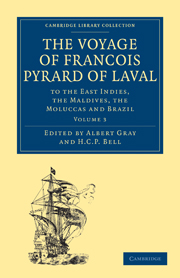Book contents
- Frontmatter
- Contents
- ADDENDA ET CORRIGENDA
- HEADINGS OF CHAPTERS
- VOYAGE: PART THE SECOND (continued)
- TREATISE OF ANIMALS, TREES, AND FRUITS
- CHAPTER I
- CHAPTER II
- CHAPTER III
- CHAPTER IV
- CHAPTER V
- CHAPTER VI
- CHAPTER VII
- CHAPTER VIII
- CHAPTER IX
- CHAPTER X
- CHAPTER XI
- CHAPTER XII
- ADVICE FOR THE VOYAGE TO THE EAST INDIES
- DICTIONARY OF SOME WORDS OF THE MALDIVE LANGUAGE
- APPENDIX
- GENERAL INDEX
- Plate section
CHAPTER IV
Published online by Cambridge University Press: 04 April 2011
- Frontmatter
- Contents
- ADDENDA ET CORRIGENDA
- HEADINGS OF CHAPTERS
- VOYAGE: PART THE SECOND (continued)
- TREATISE OF ANIMALS, TREES, AND FRUITS
- CHAPTER I
- CHAPTER II
- CHAPTER III
- CHAPTER IV
- CHAPTER V
- CHAPTER VI
- CHAPTER VII
- CHAPTER VIII
- CHAPTER IX
- CHAPTER X
- CHAPTER XI
- CHAPTER XII
- ADVICE FOR THE VOYAGE TO THE EAST INDIES
- DICTIONARY OF SOME WORDS OF THE MALDIVE LANGUAGE
- APPENDIX
- GENERAL INDEX
- Plate section
Summary
All India, Africa, Brazil, and the islands adjacent thereto abound (amongst many other sorts of birds) with vast numbers of parrots of all kinds. Some are of a grey and violet plumage: these are found in the island of St. Lawrence, and are good eating, of the same flavour as wood pigeons; we ate many of them during our sojourn there. The largest green parrots brought home here come from Guinea, Cape Verd, and Brazil. Those of the Indies are green too, but smaller, more tractable, and speak passing well. There is another kind, very large and all white. You see also little parrots no bigger than sparrows. In Brazil, some are all red, some all yellow, and of many other single colours: these are all much bigger than the others. As for herons, they frequent the sea, and are to be seen in great numbers under the Torrid Zone.
While I was at the Maldives a bird landed upon one of the islands, of prodigious form and size. This bird is three feet in height, the body exceedingly thick, more than a man could embrace; the plumage is all white, like a swan's; the feet are flat, as with birds that swim; the neck is half a fathom, and the beak half an ell in length; at the end of the beak above is a kind of crooked hook; the lower jaw is much larger than the upper, and has a large pocket depending therefrom, very capacious, and of a yellowish golden colour, like parchment.
- Type
- Chapter
- Information
- The Voyage of François Pyrard of Laval to the East Indies, the Maldives, the Moluccas and Brazil , pp. 352 - 355Publisher: Cambridge University PressPrint publication year: 2010First published in: 1890

